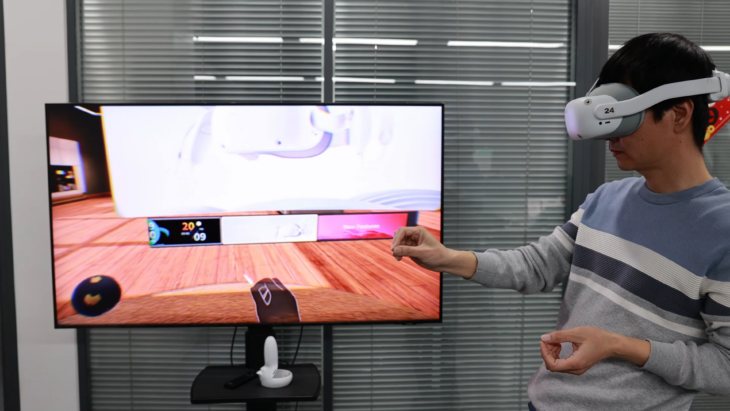Augmented Reality (AR) has rapidly evolved, transforming how we interact with digital content. At the core of this transformation is the advancement in AR hand tracking and gesture recognition. This technology has transcended traditional input methods, enabling a more intuitive and immersive experience.
In this guide, we will dissect how AR hand tracking and gesture recognition operate, its applications, challenges, and future prospects. Our focus is not just on the technical details but also on its practical implications in various industries.
Table of Contents
ToggleThe Basics of AR Hand Tracking
![]()
AR hand tracking refers to the ability of AR systems to detect, track, and interpret the movements of a user’s hands. This technology allows users to interact with augmented reality environments in a natural and intuitive way, using their hands as they would in the real world.
The key to this technology lies in sophisticated algorithms and sensor technology. For a deeper insight into the technologies and applications of AR hand tracking and gesture recognition, including their use in mobile AR experiences and interactive applications, click here.
The Role of Sensors and Cameras
The foundation of AR hand tracking is built on a combination of sensors and cameras. These components capture the movement and position of the hands in real-time.
Cameras, often depth-sensing, provide a three-dimensional view of the scene, which is crucial for accurately interpreting hand positions and movements. Sensors, such as accelerometers and gyroscopes, further enhance the accuracy by tracking the orientation and motion.
Processing and Interpretation
Once the data is captured, it undergoes complex processing. Algorithms play a pivotal role in interpreting the raw data, distinguishing hand movements from other objects in view, and translating them into meaningful interactions within the AR environment.
This process involves a combination of computer vision, machine learning, and sometimes, artificial neural networks.
Gesture Recognition in AR

Gesture recognition in AR involves the system’s ability to understand specific hand movements and shapes as commands. These gestures can range from simple actions like a pinch or swipe to more complex configurations involving multiple fingers or hand postures.
Recognition Techniques
Several techniques are employed for gesture recognition in AR. One common method is pattern recognition, where the system matches the observed hand configuration against a pre-defined set of gestures.
Machine learning algorithms, especially deep learning, are increasingly used to improve recognition accuracy by learning from a vast dataset of hand gestures.
Real-time Interaction
For gesture recognition to be effective in AR, it must occur in real time. This requirement demands not only fast processing of visual data but also efficient algorithms that can make split-second decisions.
The goal is to achieve an interaction that feels as seamless and responsive as interacting with the physical world.
Applications and Impact of AR Hand Tracking and Gesture Recognition
![]()
Enhancing Gaming and Entertainment
One of the most prominent applications of AR hand tracking and gesture recognition is in the gaming and entertainment industry. It allows for more immersive gameplay, where players can use natural hand movements to interact with the game environment, offering a more engaging and intuitive experience.
Revolutionizing Healthcare
In healthcare, AR hand tracking is used for surgical training, rehabilitation, and even during actual surgical procedures. It enables surgeons to manipulate digital information in sterile environments without physical contact, thus maintaining hygiene and focus.
Transforming Education and Training
AR hand tracking is also revolutionizing education and training. It enables interactive learning experiences where students can manipulate virtual objects with their hands, making learning more engaging and effective.
This technology is particularly beneficial in fields like engineering and physics, where understanding spatial relationships is crucial.
Challenges and Future Directions
![]()
Despite its advancements, AR hand tracking and gesture recognition still face technical challenges. These include limitations in sensor accuracy, difficulties in tracking in complex environments, and the need for robust algorithms that can handle a diverse range of hand shapes and sizes.
Improving User Experience
Enhancing the user experience is another critical area. This involves reducing latency, increasing accuracy, and developing more intuitive gesture libraries that feel natural to a broader user base.
Future Prospects
Looking ahead, the future of AR hand tracking and gesture recognition is bright. We can anticipate further integration with AI and machine learning, leading to even more accurate and intuitive systems.
The potential applications are vast, extending to virtually every industry, from automotive to retail.
Advanced Technologies Enhancing AR Hand Tracking
![]()
Innovations in Sensor Technology
The evolution of sensor technology has been crucial in advancing AR hand tracking. Innovations in miniaturization and sensitivity of sensors have allowed for more precise detection of hand movements.
This advancement means smaller, more efficient sensors can be integrated into AR devices without compromising performance.
Integration of Artificial Intelligence
Artificial intelligence (AI), particularly machine learning, has transformed the landscape of gesture recognition in AR. By learning from vast datasets, AI algorithms can more accurately interpret complex hand gestures and even adapt to individual user’s hand movements over time.
This adaptability enhances the personalization of AR experiences.
The Role of Haptic Feedback
Haptic feedback technology is starting to play a significant role in AR hand tracking. It involves providing tactile feedback to users, mimicking the sensation of touching or manipulating virtual objects.
This feedback adds a layer of realism to AR experiences, making them more immersive and interactive.
FAQs
![]()
Can AR Hand Tracking Work in Low Light Conditions?
Yes, modern AR hand-tracking systems often use infrared sensors and cameras, which allow them to function effectively in low-light conditions. However, performance may vary depending on the specific technology used.
Is It Possible to Customize Gestures in AR Applications?
Yes, many AR systems allow users to customize gestures. Developers can program specific gestures to trigger different commands, making the experience more user-friendly and adaptable to individual preferences.
Do AR Hand Tracking Technologies Require Wearing Special Gloves or Markers?
No, most modern AR hand-tracking systems do not require special gloves or markers. They rely on advanced cameras and sensors to detect and interpret natural hand movements directly.
How Does AR Hand Tracking Handle Complex Backgrounds or Multiple Users?
Advanced AR systems use sophisticated algorithms to isolate hand movements from complex backgrounds. For multiple users, systems can track individual hand movements separately, though this can be more challenging and depends on the system’s capabilities.
Can AR Hand Tracking Be Used for Sign Language Interpretation?
While still an area of ongoing research, some AR systems are being developed to recognize sign language. These systems require highly accurate gesture recognition capabilities to interpret the nuances of sign language accurately.
Is There a Lag in Response Time when Using AR Hand Tracking?
Modern AR hand tracking systems aim for minimal lag, but some degree of latency can occur, especially in systems with complex processing requirements or lower computational power. Ongoing technological improvements are continuously reducing this latency.
Final Words
AR hand tracking and gesture recognition represent a significant leap forward in how we interact with technology. By allowing for more natural and intuitive user experiences, they are set to revolutionize various industries.
As we continue to refine and enhance these technologies, we can expect them to become an integral part of our digital lives, blurring the lines between the physical and digital worlds.

